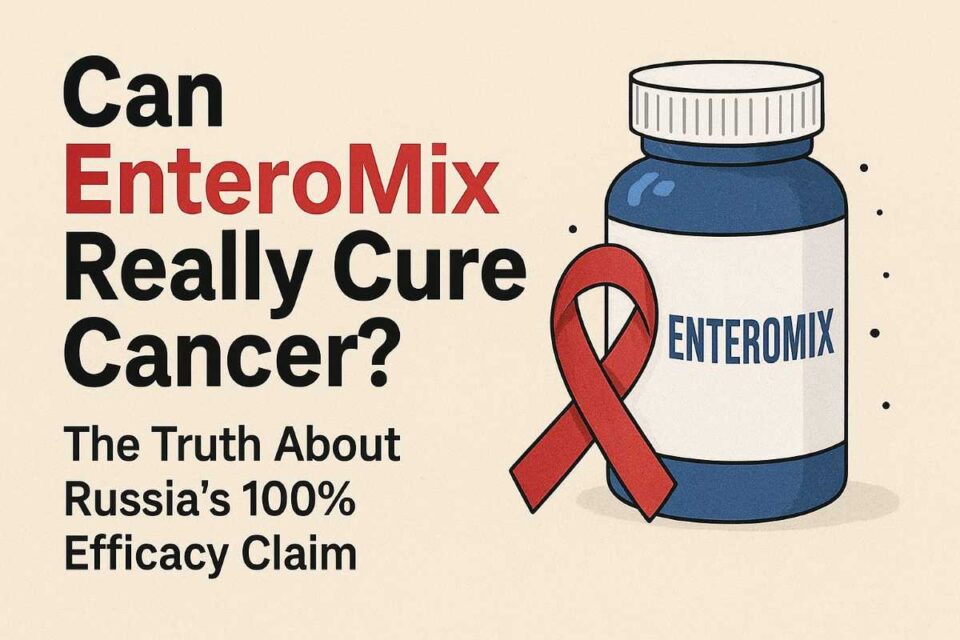Cancer research just got a bold announcement: Russia’s EnteroMix vaccine has reportedly shown 100% efficacy in clinical trials. That sounds incredible—almost too good to be true. Let’s break down what’s behind the headlines and what this really means for cancer treatment worldwide.
1. What Is EnteroMix—and Why the Buzz?
EnteroMix is not your typical vaccine. Developed by Russia’s National Medical Research Radiological Center (NMRRC) in collaboration with the Engelhardt Institute of Molecular Biology, it’s an oncolytic vaccine made from four non-pathogenic viruses. These viruses are designed to attack cancer cells directly while also boosting the body’s immune system to fight tumors.
The vaccine has advanced through several years of preclinical testing—think full-scale animal studies—showing promising results like slowed tumor growth, and in some cases, complete tumor destruction.
By mid-2025, the EnteroMix cancer vaccine advanced to its first human trials, known as Phase I. These early trials involve about 48 volunteers and focus primarily on evaluating safety, toxicity, and basic efficacy. So far, toxicity levels have been described as “very low.”
2. What Does “100% Efficacy” Mean Here?
Today’s news reports are momentous: 100% efficacy and safety in clinical trials. But we need to dig deeper:
Phase I trials are small-scale and designed to check safety, not to prove full-blown effectiveness. Results claiming 100% efficacy from these trials are extremely rare—even exceptional.
It’s also unclear if the 100% refers to all participants responding, complete tumor remission, or something else entirely. Without seeing peer-reviewed data or specifics—like patient outcomes or criteria used—these claims warrant caution.
In short: while the result is astonishing, we need more transparency on what exactly was measured and how.
3. How It Works — A Look at the Science
EnteroMix is built on a dual approach:
Direct Attack: The viruses infect tumors and begin destroying malignant cells—acting like a microscopic Trojan horse within the body.
Immune Activation: As the viruses dismantle cancer cells, the immune system gets “trained” to recognize and fight similar cells going forward.
These mechanisms make it particularly exciting, as it harnesses both biological warfare and immune memory.
4. How Far From Real-World Impact?
Timing and logistics are still unfolding:
Preclinical trials wrapped up just recently; Phase I is underway in mid-2025.
At least two cancer-focused vaccine approaches are in development in Russia: EnteroMix (oncolytic viruses) and personalized mRNA vaccines, which adapt to individual tumor genetics.
Health authorities plan to provide the vaccine free to Russian patients, despite an estimated cost of ~300,000 rubles per dose (roughly $3,000 USD).
Phase II and III trials—necessary for confirming true effectiveness—have not yet begun. These steps could take years before the vaccine becomes widely available (if it passes).
5. Why This Matters—and What to Watch For
Why it matters:
If EnteroMix truly performs safely and effectively in humans, it could open a new frontier in cancer treatment by combining viral therapy and immunotherapy. That 100% claim may ignite global attention and investment—but scientific rigor must follow.
What to look out for next:
Peer-reviewed journal articles showing detailed clinical data.
Phase II/III trial results, with larger patient groups and controlled comparisons.
Updates on international availability or partnerships, especially if Russia plans to license the vaccine abroad.
6. How Experts and Patients See It
Globally, cancer specialists are reacting with a mix of hope and skepticism. On one hand, the concept of using viruses against cancer has been around for decades, but progress has been slow. The promise of 100% success, even in small studies, is enough to make headlines everywhere.
Patients and their loved ones view EnteroMix as a potential sign of hope after years of uncertainty. For those living with aggressive cancers, even the possibility of a vaccine that can destroy tumors and prevent recurrence feels life-changing.
However, experts warn against false hope too soon. Until results are confirmed in larger trials and published in scientific journals, the news should be treated as a promising step—not a guaranteed cure.
7. Comparing EnteroMix With Other Cancer Vaccines
Russia isn’t alone in racing to develop cancer vaccines. Several Western companies and research groups are working on mRNA-based cancer vaccines—similar to COVID-19 vaccines, but customized to each patient’s tumor. Early results from trials by companies like Moderna and BioNTech are also encouraging, though not yet definitive.
EnteroMix stands out because it’s not personalized. Instead, it uses a universal virus-based approach that could be easier to manufacture and distribute if proven effective. This difference could make it more practical for large-scale use, especially in countries with limited healthcare resources.
🌍 Final Thoughts: A Step Toward Hope
The claim that EnteroMix achieved 100% success in clinical trials is both eye-catching and potentially game-changing. But here’s the bottom line:
So far, trials have been limited, focused on safety, and small in scale.
The claim is exciting—but we need more transparency, larger studies, and peer-reviewed evidence to confirm it.
If the vaccine continues to deliver, it could transform cancer care—not just in Russia, but worldwide.
Until then, the scientific community and public should stay informed, cautiously optimistic, and supportive of further research.

